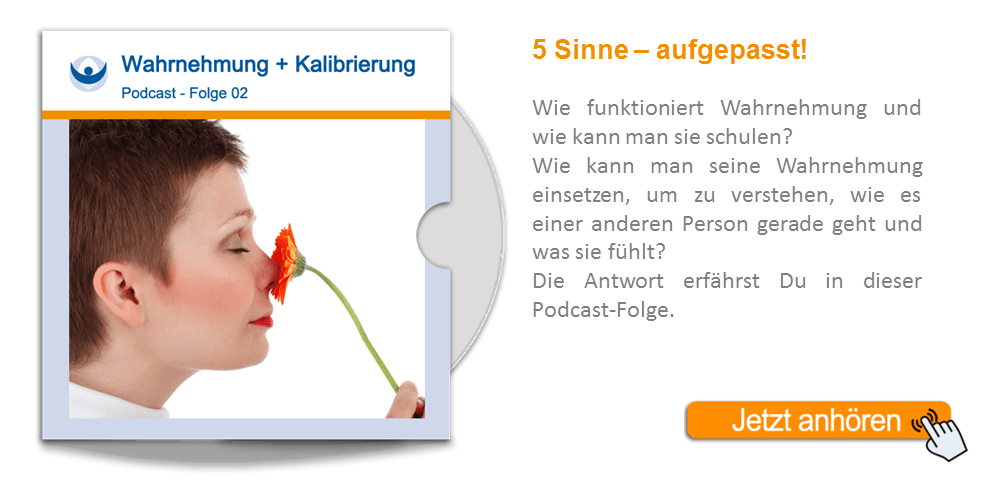Calibrating
When perceiving others, it’s not only important to pay attention to general patterns, but also to attune yourself individually to the person in front of you. NLP rejects one-size-fits-all rules that assign fixed meanings to body language. Instead, NLP developed the concept of calibration, which puts a person’s individuality front and center.
Calibrating is the sensory fine-tuning to another person’s behavioral expressions. Specific inner states correlate with specific outward physiologies. When I guide someone through a process, it’s useful to know their “physiologies” so I can steer the process at any time and know where the other person currently is.
Calibrating is the ability to recognize externally observable cues and associate them with an inner state. For example, once I’ve attuned to someone, I may notice a subtle facial change that tells me whether a suggestion lands well—or whether more arguments are needed.
By calibrating carefully, I get feedback about whether my interventions are effective. I receive information about the other person so I can adapt my communication accordingly.
In NLP, calibration refers to “the process of tuning in to the nonverbal signals that indicate a particular state in the other person.”
Grinder & Bandler, 1987
Calibration requires the ability to perceive nonverbal signals precisely and to link the physiology of inner states to outward signs.
“To calibrate means knowing what your partner is doing internally (e.g., which experience they are recalling), while carefully observing how this appears externally (their physiology) and remembering it.”
Mohl, 1996
Distinction & tip: Calibration is not pacing. However, the refined perception required for calibration is an important prerequisite for pacing. Calibration simply means that I read information from voice, face, or other bodily reactions. Whether I mirror these (pace) is a separate choice.
Calibration Exercises
Exercise for Visual Calibration: Guess the Person
Groups of three: A, B and C. About 10 minutes, then switch roles.
- A thinks for about 45 seconds of a person they like (=Person X). B helps A to recall as vivid and clear a memory as possible. B and C calibrate to breathing, facial expression, skin tone, etc. (=physiology).
- A then thinks for about 45 seconds of a person they don’t like (=Person Y). B again helps A recall a vivid memory. B and C calibrate to breathing, facial expression, skin tone, etc. (=physiology).
- B asks A the following questions. A answers by thinking of the relevant person—without speaking. B and C read from A’s physiology whether it’s Person X or Y.
- Which person is more spirited?
- Which person has darker hair?
- Which person is taller/older/heavier/more attractive?
- Which person lives farther away?
- Which person did you see most recently?
- Which person has the bigger car?
- Which person … ?
B and C continue asking until both can reliably recognize A’s nonverbal answer. If you’re completely off, go back to steps 1) and 2) and recalibrate.
Exercise for Auditory Calibration
Groups of three: A, B and C. About 5–10 minutes, then switch roles.
- A keeps their eyes closed.
- B makes a sound (e.g., finger snap, clap) and then says their name.
- C copies B’s sound as closely as possible and then says their name.
- Repeat steps 2) and 3) until A believes they can hear the differences.
- B or C now makes the sound without saying the name. A tries to identify who it was.
- B and C try to make their sounds as similar as possible until either A gives up or “wins” by reliably hearing the subtle differences.
Exercise for Kinesthetic Calibration
Create small groups of 7–10 people.
A closes their eyes and extends a hand forward. The others take turns shaking A’s hand and saying their names—optionally in two rounds. A calibrates to each person’s handshake. Then everyone in the subgroup again shakes A’s hand, this time in a different order, and A must guess whose hand it is.
Make sure to change your positions in between so direction or sounds don’t give you away. Once someone has been correctly identified, they stop shaking hands. When A can’t assign any more hands confidently—or has identified everyone—the next person becomes A and closes their eyes. Increase difficulty by varying the handshake.

 Deutsch
Deutsch English
English Français
Français 中文
中文 Español
Español नहीं
नहीं Русский
Русский